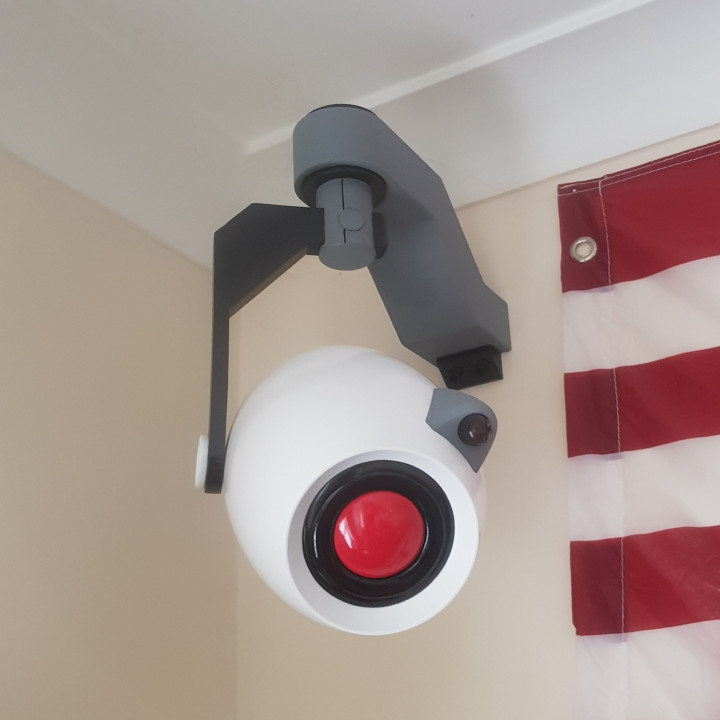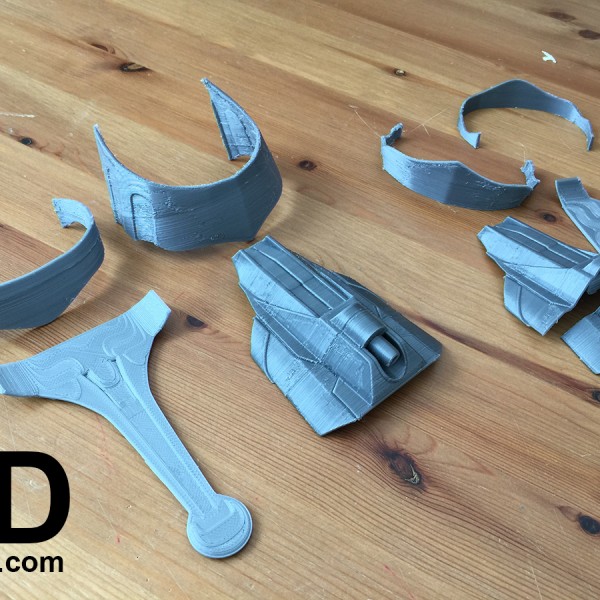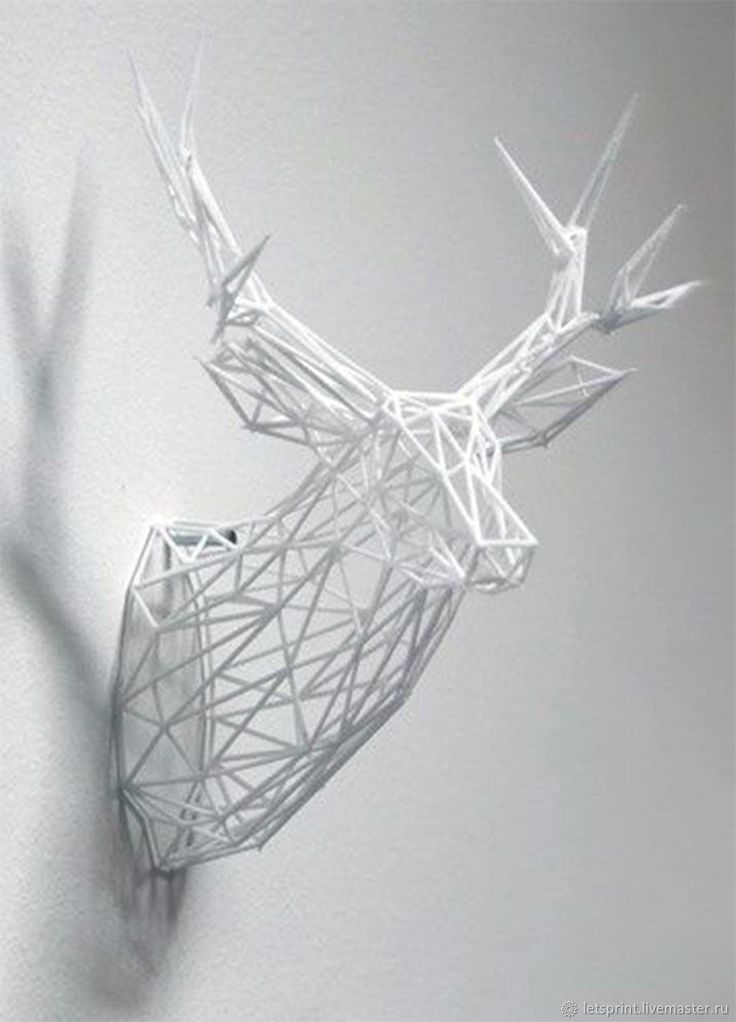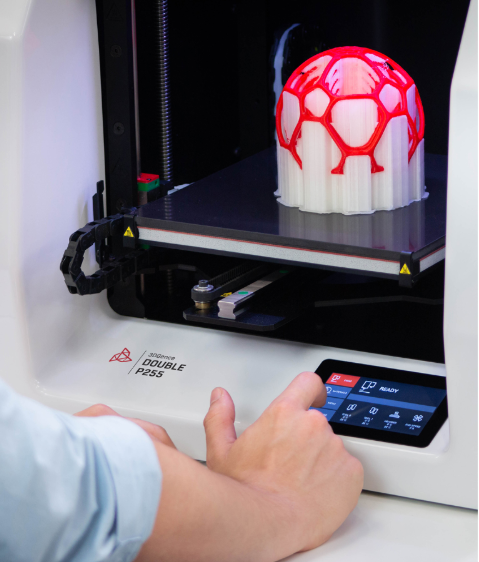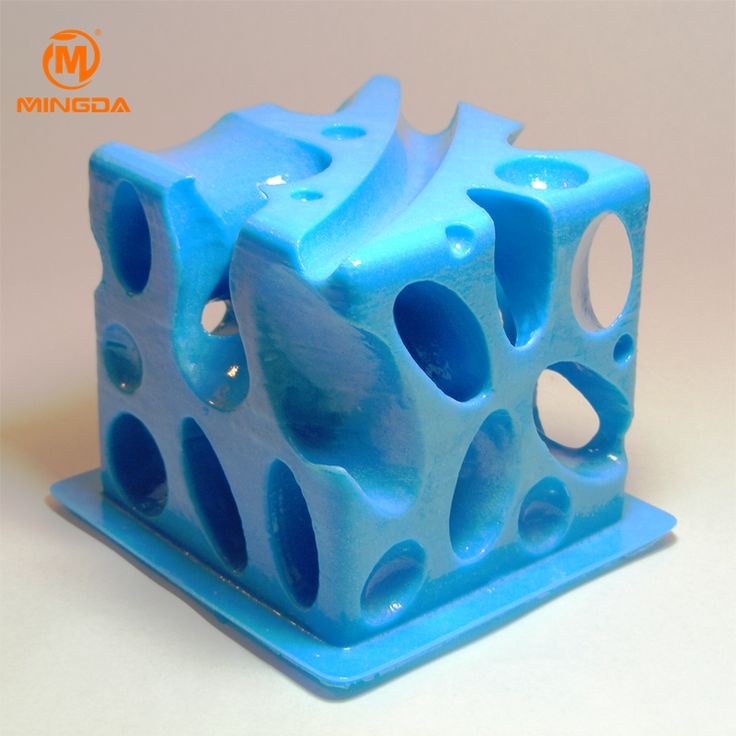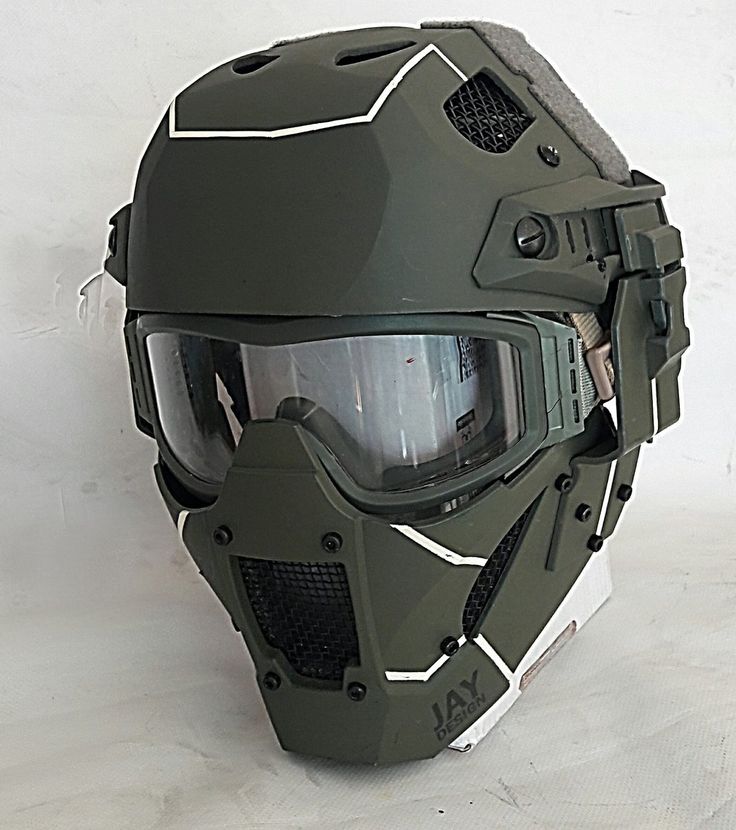3D printing conductive polymer
Electrically Conductive Polymer Composites for 3D Printing
Last week we took a look at ESD safe materials for 3D printing. These are materials that are safe against electrostatic discharge, and have uses largely in electronics manufacturing.
This article, we will look at polymer composites with lower surface resistivity, in other words, electrically conductive 3D printing feedstocks.
Conductive materials have a surface resistivity of less than 1 x 10 5 Ω/ sq. This is compared to dissivative (ESD) materials which lie in the range of 1 x 10 5 Ω/ sq to 1 x10 11 Ω/ sq.
Conductors allow electricity to flow, and so have a bunch of potential uses, ranging from 3D printed circuits, wearable tech and maybe even one day, conductive substrates for electroplating.
Here are a few options for you, depending on what type of additive manufacturing process you are using.
Extruded Materials
For a while, filaments have been available in conductive form. Similar to ESD materials, conductivity generally tends to be manipulated by addition of some form of carbon to the feedstock during filament manufacture.
There are a lot of smaller companies offering these conductive filaments, yet strangely we don’t see much from the larger companies.
Fans of tougher thermoplastics such as ABS, TPU and PC will be pleased to know there are plenty of options for conductive variants of this polymer. A google search of the term “conductive X filament” (with “X” being your thermoplastic of choice) will yield a fairly huge selection to choose from.
Sintered Materials
Anyone with access to a SLS machine will be pleased to hear that there are options available (and in development) to those who enjoy sintering things.
There is currently research underway into addition of metallic fillers such as copper and aluminium also.
There are a variety of methods involved in manufacturing electrically conductive SLS materials. Many involve the mixing of carbon into the feedstock, while others focus on actually coating the actual particles with a conductive filler, as you can see in the image below.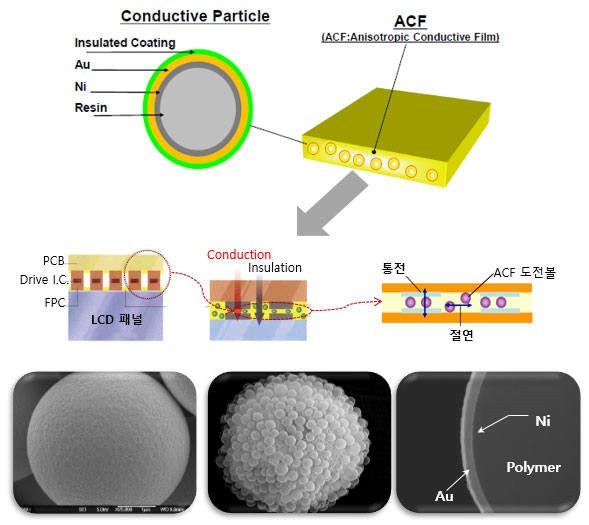
A lot of research is focused on the shape and size of the additive particles (for example spherical vs. flakes), to determine the optimum parameters for successful bonding and increased electrical conductivity.
Photopolymers
Similar to the ESD materials of last week, the selection of conductive resins is smaller than the extrusion & sintering feedstocks. Last week we pointed out that mixing carbon particles into a resin can result in the contents settling, which can require constant mixing immediately before printing.
This is one possible explanation for the small selection of these resins available.
While there aren’t many options for SLA/DLP printing conductive materials available commercially, conductive resins are being researched by various universities around the world, so there is potential for the market to grow, once manufacturers iron out the creases, whatever they may be.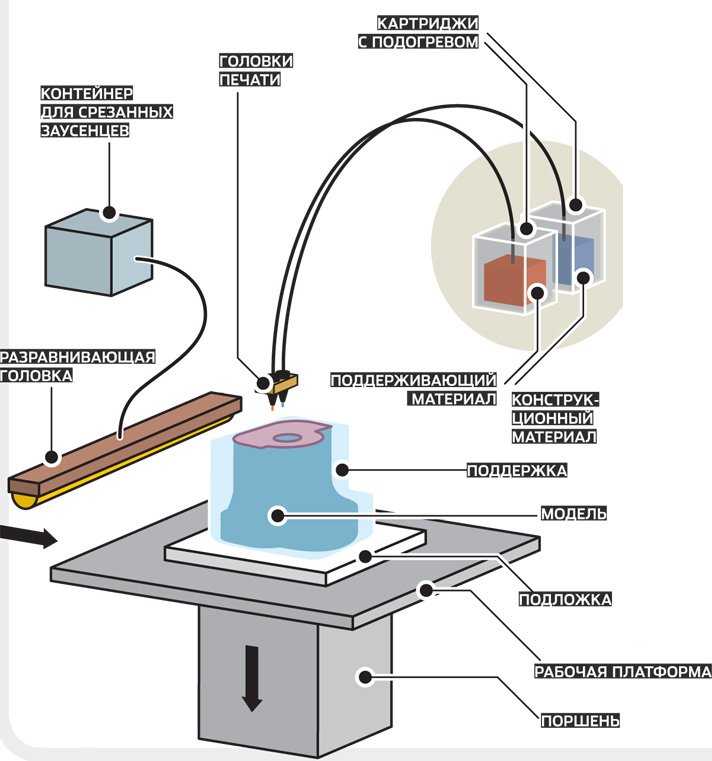
This team from Yeungnam University, South Korea, for example, has manufactured a Polyacrylate Resin Solution with Polyaniline Nanofiber and Graphene additives, for improved conductivity.
Another team, from Georgia Institute of Technology and Xi’an Jiotong University, has mixed multi-walled carbon nanotubes (MWCT) with resins and demonstrated that they show conductivity. In fact, these research resins have been shown to be very useful indeed, having been shown to be useful for electrically activated shape memory composites.
Electrically activated shape memory polymers. Image credit: Georgia Institute of TechnologyFinal Thoughts
So, those are basically your options where it comes to conductive polymer materials. Most products involve the addition of some form of carbon (typically graphene) to change the surface resistivity, but we are seeing researchers adding metals into SLS feedstocks to enhance conductivity.
Of course, if you want something truly conductive, you will be better off sticking with metal materials.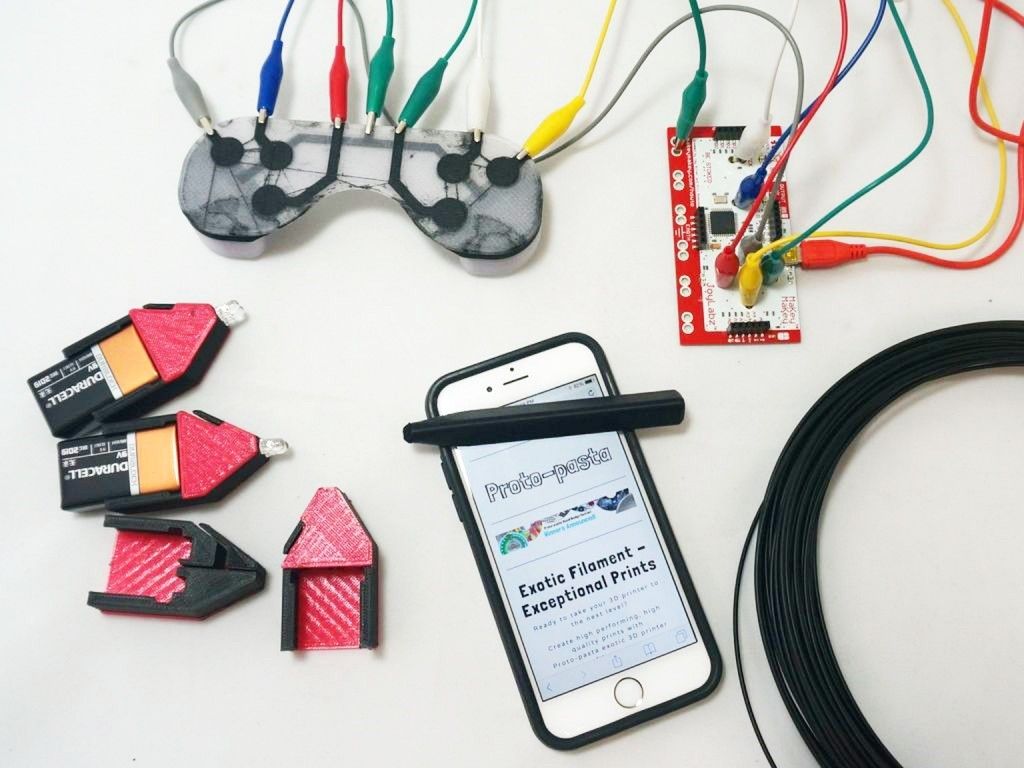 10 times LESS conductive than copper.
10 times LESS conductive than copper.
So bear that in mind when buying a conductive polymer material, and if in doubt…always read the datasheet.
3D-Printed highly stretchable conducting polymer electrodes for flexible supercapacitors
Jiayu Yang,a Qinghe Cao,a Xiaowan Tang,a Junjie Du,a Tao Yu, *a Xi Xu, a Dongming Cai,b Cao Guan *a and Wei Huanga
Author affiliations
* Corresponding authors
a
Frontiers Science Center for Flexible Electronics, Institute of Flexible Electronics, Northwestern Polytechnical University, Xi'an 710072, P.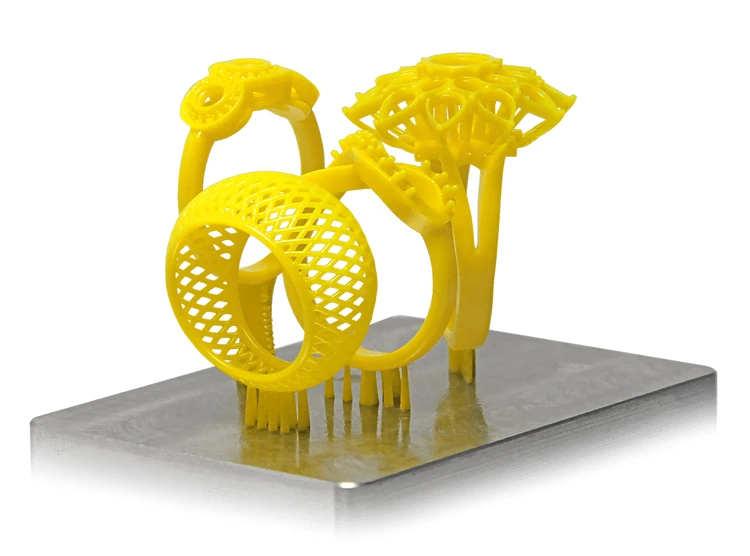 R. China
R. China
E-mail:
[email protected], [email protected]
b College of Chemical Engineering, Hubei University, Wuhan 430062, P. R. China
Abstract
Recent advances in the development of wearable, implantable, and bio-integrated electronic devices have increased the demand for stretchable and flexible energy storage devices that can deliver high degrees of mechanical deformability. However, the fabrication of fully flexible electronics with both satisfactory electrochemical performance and mechanical stretchability remains a significant technological hurdle. In this work, by synergistically combining theoretical structural design and 3D printing, additive-free free-standing stretchable electrodes with different negative Poisson's ratio (NPR) structures have been developed based on a poly(3,4-ethylenedioxythiophene):polystyrene sulfonate (PEDOT:PSS) ink. Through tensile tests and finite element analyses (FEA), the stretchable electrode with a well-designed arc-shaped NPR structure can effectively reduce the peak strain, resulting in excellent flexibility (up to 180°) and stretchability (maximum elongation 150%). Through further integration of carbon nanotubes (CNTs), the 3D printed hybrid polymer/CNT electrode exhibits enhanced electrochemical performance with a high area capacitance of 990 mF cm−2. The as-fabricated quasi-solid-state symmetric supercapacitor not only achieves a satisfactory energy density and maintains excellent capacitance retention of 74.
However, the fabrication of fully flexible electronics with both satisfactory electrochemical performance and mechanical stretchability remains a significant technological hurdle. In this work, by synergistically combining theoretical structural design and 3D printing, additive-free free-standing stretchable electrodes with different negative Poisson's ratio (NPR) structures have been developed based on a poly(3,4-ethylenedioxythiophene):polystyrene sulfonate (PEDOT:PSS) ink. Through tensile tests and finite element analyses (FEA), the stretchable electrode with a well-designed arc-shaped NPR structure can effectively reduce the peak strain, resulting in excellent flexibility (up to 180°) and stretchability (maximum elongation 150%). Through further integration of carbon nanotubes (CNTs), the 3D printed hybrid polymer/CNT electrode exhibits enhanced electrochemical performance with a high area capacitance of 990 mF cm−2. The as-fabricated quasi-solid-state symmetric supercapacitor not only achieves a satisfactory energy density and maintains excellent capacitance retention of 74. 7% after 14 000 cycles, but also shows promising mechanical properties by maintaining stable power output even when being extremely deformed. The strategy proposed here offers promising opportunities in developing novel deformable electrodes for integrated wearable energy storage devices in various applications.
7% after 14 000 cycles, but also shows promising mechanical properties by maintaining stable power output even when being extremely deformed. The strategy proposed here offers promising opportunities in developing novel deformable electrodes for integrated wearable energy storage devices in various applications.
- This article is part of the themed collection: Journal of Materials Chemistry A Emerging Investigators
Conductive polymer printed neural probe
Engineers have developed a new way to 3D print conductive polymer. Extrusion of a 7 percent solution of PEDOT:PSS polymer made it possible to quickly obtain fine structures of 30 micrometers with high reproducibility. To test the quality of the new method, the scientists printed and connected a neural probe for mice.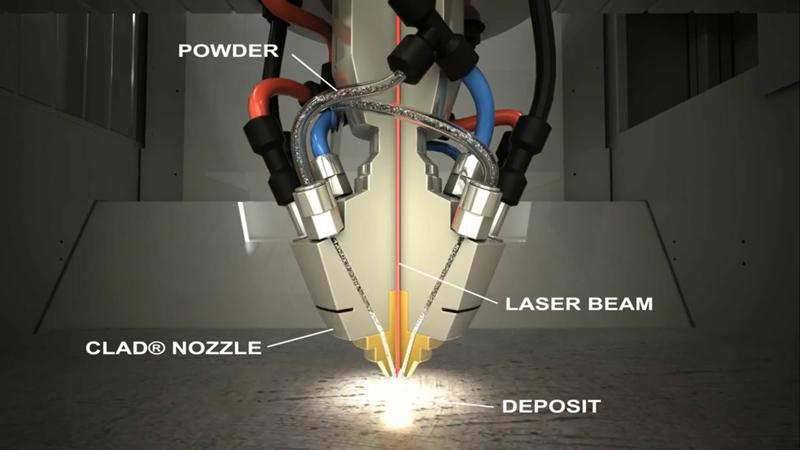 The article was published in the journal Nature Communications.
The article was published in the journal Nature Communications.
Conductive polymer materials can find applications in energy storage, flexible electronics and bioelectronics due to their electrical, mechanical and biocompatible properties. However, despite recent advances in the field of conductive polymers, the fabrication of structures and devices based on them is still limited by traditional methods, such as inkjet and screen printing, electrochemical deposition, and lithography. Each of these methods has its drawbacks and difficulties. For example, these methods are limited to low-resolution, two-dimensional structures, i.e., filament thicknesses of at least 100 micrometers, and are also very expensive and have a complex multi-step manufacturing process. These conditions prevent the widespread use of devices with conductive polymers. nine0003
On the other hand, modern 3D printing techniques provide opportunities for rapid, programmable production of micron-resolution 3D structures. To date, the list of materials that can be used in 3D printing has grown significantly: metals, hydrogels, cell aggregate bioinks, glasses, liquid crystal polymers, and ferromagnetic elastomers. But research on 3D printing of conductive polymers is limited to insulated filament printing due to the poor printability of existing conductive polymers. nine0003
To date, the list of materials that can be used in 3D printing has grown significantly: metals, hydrogels, cell aggregate bioinks, glasses, liquid crystal polymers, and ferromagnetic elastomers. But research on 3D printing of conductive polymers is limited to insulated filament printing due to the poor printability of existing conductive polymers. nine0003
MIT's Hyunwoo Yuk and his colleagues discovered a 3D-printable conductive polymer and printed it into a multi-electrode array, a high-density flexible electronic circuit, and a neural probe for the mouse hippocampus. This polymer turned out to be the long-known poly(3,4-ethylenedioxythiophene) conjugated with polystyrene sulfonate (PEDOT:PSS), an aqueous solution of which is widely available commercially.
To obtain a suitable conductive polymer paste for printing, the original aqueous polymer solution is successively frozen at liquid nitrogen temperature, lyophilized and redispersed in a solution of water and an organic solvent of dimethyl sulfoxide.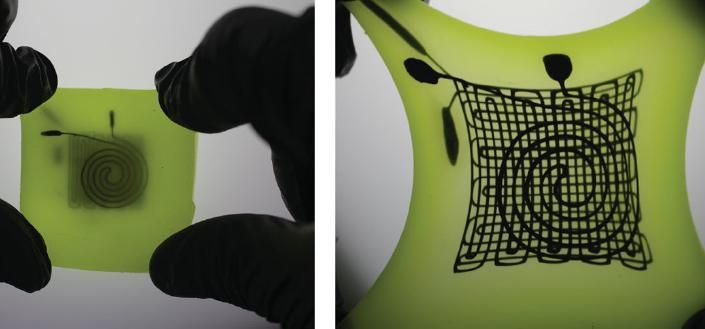 The resulting solution with a concentration of five to seven percent is acceptable for 3D printing, at a lower concentration the resulting structures liquefy, and at a higher concentration they get stuck in the extruder nozzle due to the high viscosity. The strips obtained from this material have a high resolution of 30 microns and a high fidelity of 20 layers. nine0003 Extruded polymer appearance versus solution concentration
The resulting solution with a concentration of five to seven percent is acceptable for 3D printing, at a lower concentration the resulting structures liquefy, and at a higher concentration they get stuck in the extruder nozzle due to the high viscosity. The strips obtained from this material have a high resolution of 30 microns and a high fidelity of 20 layers. nine0003 Extruded polymer appearance versus solution concentration
Dried and annealed printed products have a high conductivity of 155 siemens per centimeter and flexibility, which is very important for flexible electronics applications. Moreover, the dried articles can be returned to a soft hydrogel state with a Young's modulus of 1.1 megapascals by simply aging under humid conditions. Therefore, dry conductive polymers are wrapped in protective layers of dielectric polydimethylsiloxane, obtained by the same method. nine0003
A pure aqueous solution of PEDOT:PSS is polymer nanofilaments evenly distributed in solution with a viscosity of less than 30 poise. The scientists were inspired by 3D printing a concentrated suspension of cellulose nanofilaments and suggested that a more concentrated solution could exhibit the necessary properties for printing by entangling these filaments together. With an increase in concentration, the solution passed from a liquid state to a thixotropic state — the substance liquefies under mechanical action and thickens in its absence — due to the formation of reversible tangled networks of polymer nanothreads. The resulting polymer paste retained its ability to print for more than a month. nine0003
The scientists were inspired by 3D printing a concentrated suspension of cellulose nanofilaments and suggested that a more concentrated solution could exhibit the necessary properties for printing by entangling these filaments together. With an increase in concentration, the solution passed from a liquid state to a thixotropic state — the substance liquefies under mechanical action and thickens in its absence — due to the formation of reversible tangled networks of polymer nanothreads. The resulting polymer paste retained its ability to print for more than a month. nine0003
To confirm the ability to print, scientists conducted a series of technological tests. To begin with, they successfully printed fine meshes with filament thicknesses of 200, 100, 50, and 30 micrometers, in which they found that as the filament size decreased, the conductivity increased. They explained this fact by the fact that with a narrow nozzle, more pressure arises in the jet, and therefore the conductive polymer is denser, which increases the number of conductive polymer filaments.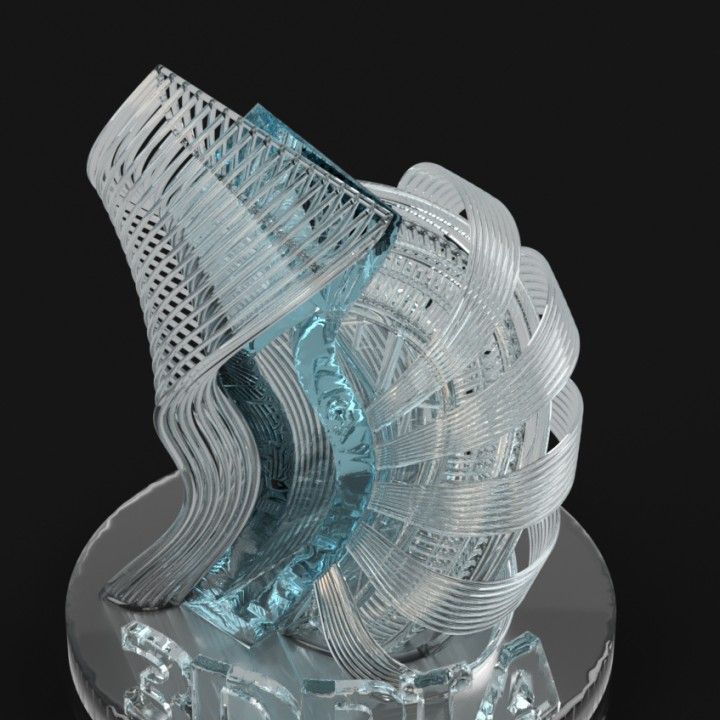 They then stacked 100-micrometer grids on top of each other in succession and obtained 20 polymer layers with high precision. To prove that 3D printing of conductive polymers can be easily combined with other printable materials, the scientists printed in half an hour the complex structure of a multi-electrode array, which is now obtained from gold by multi-stage lithography and post-assembly of components. nine0003 Fabrication of a flexible conductive polymer microcircuitReproduced multielectrode array Conductive polymer grids made of filaments of different diameters
They then stacked 100-micrometer grids on top of each other in succession and obtained 20 polymer layers with high precision. To prove that 3D printing of conductive polymers can be easily combined with other printable materials, the scientists printed in half an hour the complex structure of a multi-electrode array, which is now obtained from gold by multi-stage lithography and post-assembly of components. nine0003 Fabrication of a flexible conductive polymer microcircuitReproduced multielectrode array Conductive polymer grids made of filaments of different diameters
For a demonstration application of bioelectronics, scientists printed a neuronal probe made of a conductive polymer dressed in polydimethylsiloxane in 20 minutes. This device is designed to record the bioelectrical signals of the brain in vivo. After assembling the device, the probe was implanted in the dorsal part of the hippocampus of a laboratory mouse, which successfully walked with it for more than two weeks. nine0003
Thus, scientists have developed a fast and simple 3D printing method for the production of various devices from the common conductive polymer PEDOT:PSS, this will advance modern research to industrial use.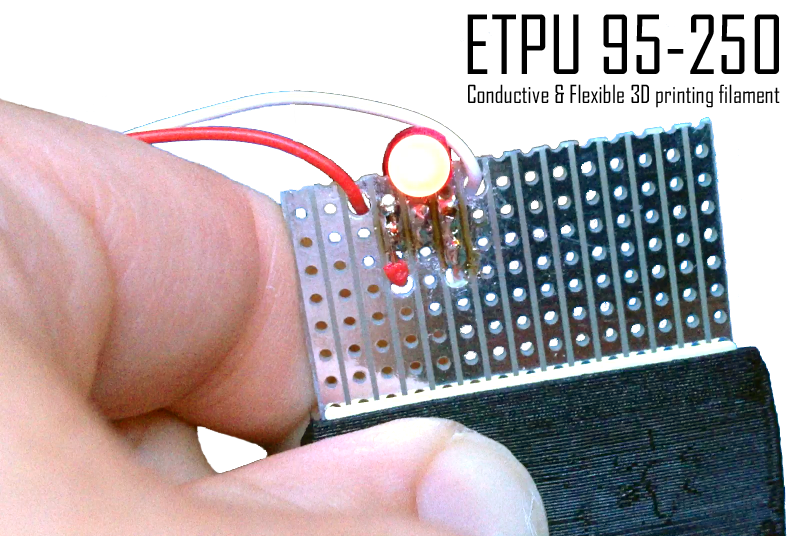
Everything you need to know about 3D printing materials
Here is a guide to help you learn about the materials used in modern industrial and home 3D printing.
When it comes to 3D printing, there is (almost) nothing impossible when it comes to materials, and researchers are constantly creating new ones. nine0003
There are certain "master" materials. The most common of these are plastics, ranging from industrial grade plastics like PEEK to very easy-to-handle plastics like PLA. Another common material is polymers, which are used in SLA printers. Composites are another category, and, as the name suggests, they are created (as if composed by a composer) by combining several materials, and the best is taken from each. The next large group of materials are metals. They are printed only by industrial machines. nine0003
In this guide, we will only consider commercially available 3D printing materials. This means that we have excluded those that cannot be bought in the store, such as biological ones.
So, it's time to start talking about what materials you can work with in 3D printing, about their applications, properties and technologies.
Which material should I choose?
Sorry, but it depends on a lot of circumstances. For example, if you need to print a food container, you will need a 3D printing material that is also food compatible, like PETG. If you want to see in advance and on a smaller scale what will then be made as a result of injection molding, then it is not necessary to immediately use expensive materials when thermoplastics such as nylon are available. nine0003
There are also additive technologies such as Binder Jetting (jet printing with a binder) or stereolithography, which greatly expanded the range of materials used in 3D printing. Many jobs that have been the domain of manual craftsmen for centuries are now automated and can be done by anyone with even the slightest understanding of 3D printing 3D modeling. Here you can point to the wide possibilities of producing full-color concepts, architectural models and visualization of art projects from paper (SDL), sandstone (Binder Jetting) and polymers (PolyJet).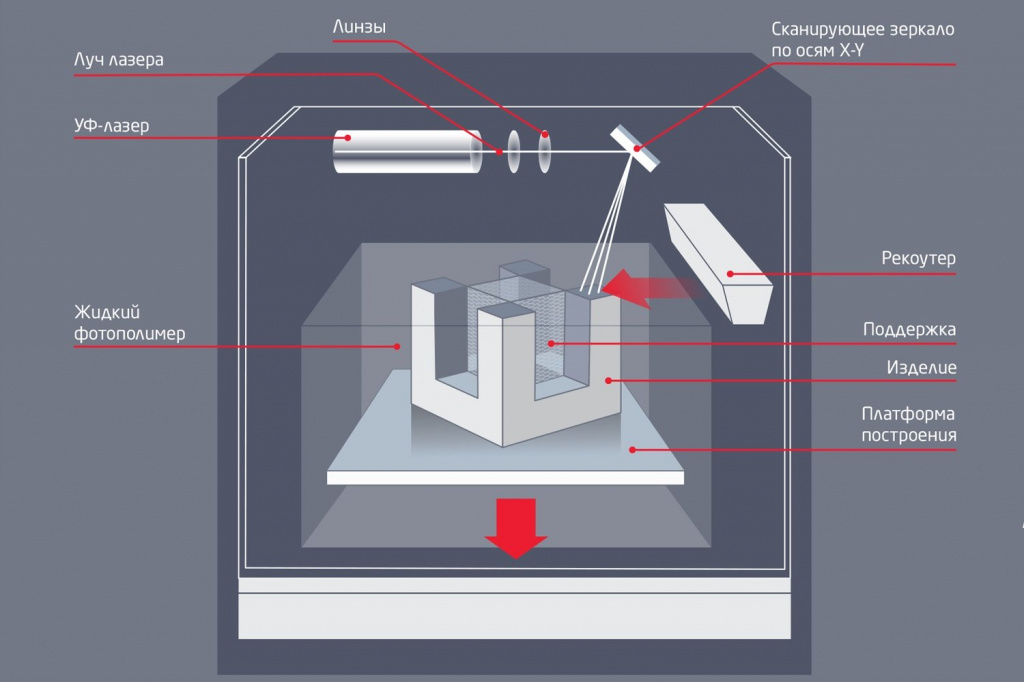 Thus, it can be said that 3D printing materials have led to a kind of democratization of rapid prototyping of design ideas. nine0003
Thus, it can be said that 3D printing materials have led to a kind of democratization of rapid prototyping of design ideas. nine0003
Materials for 3D printing with metals have revealed forms and applications that were previously unimaginable. Nowadays, it is no longer surprising that the aerospace industry is creating complex one-piece structures that use less material than before, and are therefore lighter, resulting in lower fuel consumption for aircraft compared to traditional approaches.
PLASTIC
Most consumer goods today are made from thermoplastics, so this guide to 3D printing materials would be incomplete without them. And if we talk about widespread things, then here the plastics come out in all their glory. Designers and engineers prefer to create functional prototypes from 3D printing materials with the same or very similar properties as injection molding materials, the technology that creates the final product. nine0003
Most 3D printing thermoplastics can be handled at home in much the same way as professional solutions.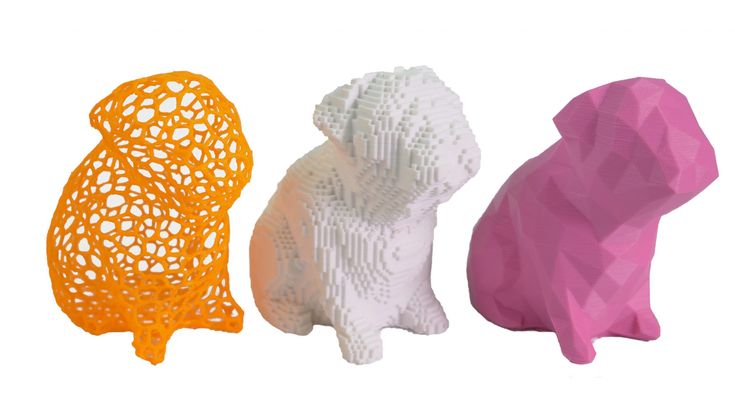 The only thing is that some experts began to stare at laser sintering instead of filament fusing (FFF).
The only thing is that some experts began to stare at laser sintering instead of filament fusing (FFF).
ABS
(Source: Wikipedia)
Do you remember the quality of Lego bricks? And this is ABS plastic, which is one of the most common materials for desktop 3D printing today.
It is completely inexpensive, strong and light. ABS filament comes in a variety of colors. There are some complaints about the smell that ABS emits when heated to its melting point, and if you're worried about that, there are alternatives like PLA. Because ABS is printed at temperatures between +220 and +250 °C, it is recommended to use a heated platform and in a closed working space so that the material cools in a controlled manner and does not warp. Also, 3D printing materials like ABS break down when exposed to atmospheric moisture, so you need to store them in airtight bags or containers. nine0003
Learn more about ABS: Everything you need to know about ABS filament for 3D printing
- Technologies: FDM, resin inkjet, SLA, PolyJetting
- Features: Rugged, lightweight, high resolution, quite flexible
- Applications: architectural models, concepts, assembly models, mass production
PLA
Another crowd favorite in our guide to 3D printing materials is PLA, which is made from cornstarch (although sugar cane and tapioca are also available). This is a simple material that exudes a pleasant sweetish aroma when heated, which is why many people prefer it over ABS. In addition, it can print disposable tableware and does not shrink as much when cooled compared to ABS. However, PLA is not as durable as ABS, and is afraid of heat. Therefore, ABS is better for any working structures. nine0003
This is a simple material that exudes a pleasant sweetish aroma when heated, which is why many people prefer it over ABS. In addition, it can print disposable tableware and does not shrink as much when cooled compared to ABS. However, PLA is not as durable as ABS, and is afraid of heat. Therefore, ABS is better for any working structures. nine0003
(Source: thingiverse)
Don't Miss: PLA Durability, Biodegradability Experiment
PLA is sold in a variety of colors and is found in many composites that give it the appearance of, for example, wood or metal. Like ABS, PLA filament breaks down when exposed to moisture in the air, so store it in airtight bags or containers.
- Technologies: FDM, SLA, SLS
- Characteristics: easy to print, no toxic smell when printed, food compatible
- Applications: concepts, assembly models, functional models, serial production
Nylon (polyamide)
Due to its flexibility and strength, nylon has become a leader in a wide range of applications, from engineering to artistic. In some places it is simply called "white plastic". Nylon printouts have a rough surface that can be easily polished. Among FDM filaments, nylon has the strongest layer bonding, making it ideal for 3D printing parts that require high tensile strength and mechanical strength. Like other thermoplastics, nylon decomposes when exposed to ambient moisture and is best stored in airtight containers or bags. nine0003
In some places it is simply called "white plastic". Nylon printouts have a rough surface that can be easily polished. Among FDM filaments, nylon has the strongest layer bonding, making it ideal for 3D printing parts that require high tensile strength and mechanical strength. Like other thermoplastics, nylon decomposes when exposed to ambient moisture and is best stored in airtight containers or bags. nine0003
- Technologies: FDM, SLS
- Characteristics: strong, smooth surface (after polishing), rather flexible, chemical resistant
- Applications: concepts, functional models, medical applications, instruments, visual arts
PEEK
PEEK is another 3D printing material designed for heavy duty parts. Plastics of this family perfectly tolerate mechanical stresses, temperature fluctuations and chemical influences. And that's not it. PEEK parts can be irradiated with X-rays and gamma rays. And with such reliability, this material is easily processed and produced.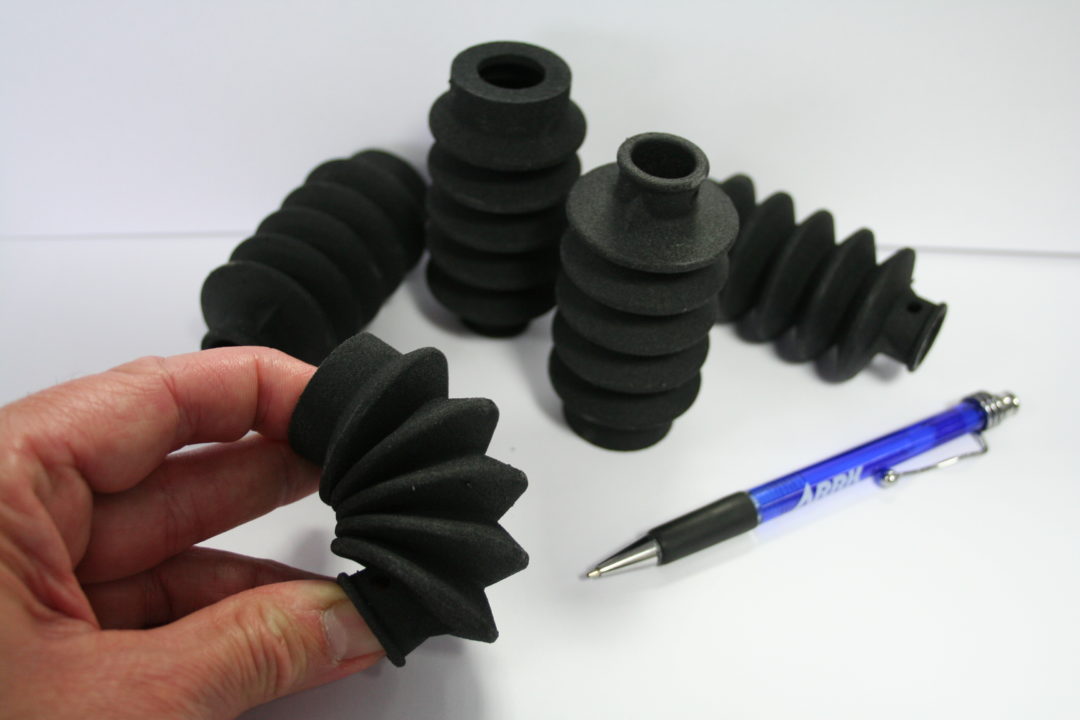 But here there is an ambush in the temperature, which in a 3D printer should reach +400 ° C, and it is better to entrust such work to professionals. In addition to high cost, security considerations can also be an argument for abandoning it. PEEK materials with their excellent properties are used in the most demanding applications - automotive, aerospace, chemical and medical industries. In particular, medical instruments and semiconductor components can be mentioned. nine0003
But here there is an ambush in the temperature, which in a 3D printer should reach +400 ° C, and it is better to entrust such work to professionals. In addition to high cost, security considerations can also be an argument for abandoning it. PEEK materials with their excellent properties are used in the most demanding applications - automotive, aerospace, chemical and medical industries. In particular, medical instruments and semiconductor components can be mentioned. nine0003
- Technologies: FDM, SLS
- Characteristics: biocompatible, very durable, heat resistant, wear resistant
- Applications: series production (automotive, aerospace, chemical and medical industries)
PET
Our next 3D printing material is PET, the material used to make plastic bottles, another alternative to ABS. Unlike ABS, PET does not stink when melted and is strong and flexible without the stench. More importantly, PET does not require heated print bed. The material gives a shiny surface, it is not hazardous to food, and this in some cases makes it a popular choice. Store PET materials for 3D printing in airtight bags or containers, the material is afraid of moisture. nine0003
The material gives a shiny surface, it is not hazardous to food, and this in some cases makes it a popular choice. Store PET materials for 3D printing in airtight bags or containers, the material is afraid of moisture. nine0003
- Technologies: FDM
- Characteristics: durable, food compatible, flexible, gives a smooth surface
- Applications: assembly models, mass production, functional models
PETG
PETG is a version of PET combined with glycol that has received a number of desirable properties in the 3D printing business, such as high transparency. What's more, PETG materials can be printed at lower temperatures and at higher flow rates (up to 100 mm/s), which speeds up production. PETG objects are not afraid of the weather, so they can often be found in gardens. Another commercial quality is food compatibility. Store PETG in airtight bags or containers, the material is afraid of moisture. nine0003
Don't Miss: All You Need to Know About 3D Printing with PETG Filament
- Technologies: FDM
- Features: Rugged, food grade, all weather, flame retardant
- Applications: concepts, assembly models, functional models, serial production
ULTEM
ULTEM is an amazing 3D printing material often found in demanding applications. On the one hand, the plastics of this family perfectly tolerate mechanical stresses, temperature fluctuations and chemical influences, but at the same time they are easy to process and obtain. The only problem is heat resistance, because the extrusion temperature in a 3D printer must reach +400 ° C, and for safety reasons, it is better not to do this work at home, but to entrust it to specialized 3D printing services. Due to its ruggedness, ULTEM is used in the most demanding applications in the automotive, aerospace, chemical and medical industries. It can be found in electrical circuits, medical instruments, and microchip sockets. nine0003
On the one hand, the plastics of this family perfectly tolerate mechanical stresses, temperature fluctuations and chemical influences, but at the same time they are easy to process and obtain. The only problem is heat resistance, because the extrusion temperature in a 3D printer must reach +400 ° C, and for safety reasons, it is better not to do this work at home, but to entrust it to specialized 3D printing services. Due to its ruggedness, ULTEM is used in the most demanding applications in the automotive, aerospace, chemical and medical industries. It can be found in electrical circuits, medical instruments, and microchip sockets. nine0003
- Technologies: FDM, SLS
- Characteristics: biocompatible, very durable, heat resistant, wear resistant
- Applications: series production (automotive, aerospace, chemical and medical industries)
HIPS
HIPS has two main applications. First of all, it is often used in FDM or SLA printing as a backing material because it dissolves in a substance called limonene. With similar properties, HIPS works best in combination with ABS. But, if you decipher the name of this plastic, and HIPS is High-Impact Polystyrene, i.e. high-impact polystyrene, it becomes clear why it is also widely used for the manufacture of containers and in general where increased impact resistance is important. When printing, HIPS gives off fumes, so the room must be ventilated, especially at home. Like many other materials for 3D printing, this one is also capricious in relation to environmental conditions, so it must be stored tightly. nine0003
With similar properties, HIPS works best in combination with ABS. But, if you decipher the name of this plastic, and HIPS is High-Impact Polystyrene, i.e. high-impact polystyrene, it becomes clear why it is also widely used for the manufacture of containers and in general where increased impact resistance is important. When printing, HIPS gives off fumes, so the room must be ventilated, especially at home. Like many other materials for 3D printing, this one is also capricious in relation to environmental conditions, so it must be stored tightly. nine0003
- Technologies: FDM, SLA
- Characteristics: soluble, soft to the touch
- Applications: assembly models, print stands, shipping containers
PVA
PVA, like HIPS, was designed as a soluble support material, but unlike all other similar materials, it dissolves in plain water. And, like most filaments, it needs to be stored in an airtight container.
- Technologies: FDM
- Characteristics: instant
- Applications: assembly models, printing supports
COMPOSITES
Composites are filaments made up of several materials and using the best qualities of each.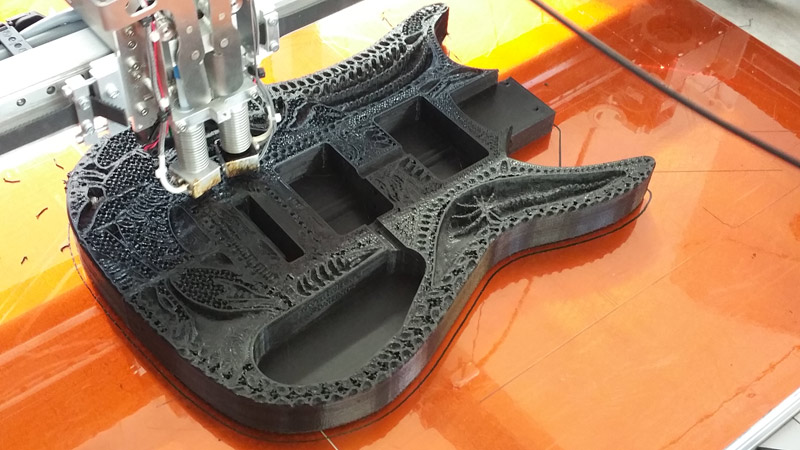 PLA, for example, can be paired with everything from wood to metal. Other composites are targeted at specific industries or applications and are used, for example, in engineering applications.
PLA, for example, can be paired with everything from wood to metal. Other composites are targeted at specific industries or applications and are used, for example, in engineering applications.
Conductive
A relatively new addition to the filament shelf are 3D printed conductive materials that open up many interesting possibilities. Such materials can be used, for example, in touch panels or in MIDI instruments. Other uses for conductive composites are wearable electronics, computer-to-computer interfaces, Arduino boards, and more for DIY projects. Conductive filaments for 3D printing are usually based on PLA or ABS, each with its pros and cons. Conductive ABS is more durable and heat-resistant than PLA-based, but has the same odor issues as regular ABS. nine0003
- Technologies: FDM
- Features: conductive
- Applications: DIY projects
Metal-plastic filament
All "metal" filaments on the market are actually thermoplastics mixed with a small amount of metal. Such 3D printing materials allow you to create objects with the visual properties of these metals. Metal-plastic filaments are heavier than conventional thermoplastics. Popular composites for 3D printing are bronze, copper, steel, and iron. Keep in mind that these printouts require post-processing to make them look like metal. Also make sure your printer's nozzle can handle this material. nine0003
Such 3D printing materials allow you to create objects with the visual properties of these metals. Metal-plastic filaments are heavier than conventional thermoplastics. Popular composites for 3D printing are bronze, copper, steel, and iron. Keep in mind that these printouts require post-processing to make them look like metal. Also make sure your printer's nozzle can handle this material. nine0003
- Technologies: FDM
- Features: metal look
- Applications: fine arts
Alumide
This is a nylon version with aluminum particles. In terms of durability and physical characteristics, it is very similar to nylon. The difference is that it is shiny, wear-resistant and has a porous surface. Objects printed with aluminium can be very precise in size, durable and long lasting. Alumide, like other similar materials for 3D printing, lends itself well to various kinds of post-processing, such as polishing and coating. nine0003
- Technologies: SLS
- Features: Rugged, heat resistant, high resolution
- Applications: DIY projects, functional prototypes, mass production
Wood
Human inquisitiveness knows no bounds, so it was only a matter of time before the engineers succeeded in adding wood fibers to plastic filament.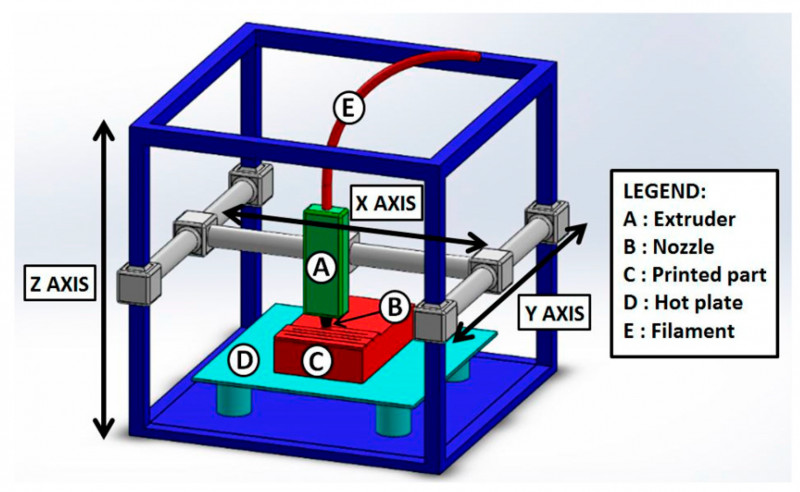 Wood 3D prints can be processed like real ones, they can be sawn, sanded and painted. And while this kind of exotic 3D printing material is aesthetically pleasing, it doesn't have the same functional characteristics as the original. For example, you will not be able to make a chair out of it. nine0003
Wood 3D prints can be processed like real ones, they can be sawn, sanded and painted. And while this kind of exotic 3D printing material is aesthetically pleasing, it doesn't have the same functional characteristics as the original. For example, you will not be able to make a chair out of it. nine0003
Interestingly, by changing the extrusion temperature, it is possible to change the shades of brown in the wood filament. 3D printing at a lower temperature produces a very light shade, while at a higher temperature it produces a solid dark brown. Therefore, if you decide to imitate growth rings in a printout, play with temperature. Depending on the brand of wood filament, the printing process may be accompanied by the smell of wood. Some manufacturers offer a wide selection of such material - birch, olive, bamboo, willow ...
- Technologies: FDM
- Features: fragile
- Applications: concept models, fine arts
METALS
Our guide to 3D printing materials would be incomplete without metals. Metal 3D printing has gained particular popularity in the aerospace, automotive and medical industries for its ability to create complex designs that do not require additional welding or machining. The disadvantage of these materials is that they require a lot of experience in development and combination. nine0003
Metal 3D printing has gained particular popularity in the aerospace, automotive and medical industries for its ability to create complex designs that do not require additional welding or machining. The disadvantage of these materials is that they require a lot of experience in development and combination. nine0003
In addition, they cannot be printed at home because they require high temperatures and large, specialized printers.
Learn more about metal 3D printing in our comprehensive article Everything you need to know about metal 3D printing
Aluminum
wide range of applications. Basically, we are talking about different alloys based on it. Aluminum elements can have thin walls and complex geometries, they tolerate physical stresses and high temperatures well, which is extremely important for low-cost prototypes, functional models, in particular for engines in the automotive and aerospace industries. nine0003
- Technologies: direct metal deposition, binder inkjet printing
- Characteristics: light, strong, heat-resistant, not afraid of corrosion
- Applications: functional models, mass production (automotive and aerospace)
Cobalt Chrome
The next material on the list is used for very serious applications. Chrome-cobalt is sometimes referred to as chromium-cobalt-molybdenum or cobalt-chromium, and sometimes simply as a superalloy. Its main use is in medical applications and in the aerospace industry, where it can be found in turbines and jet engines. It has outstanding strength, heat and corrosion resistance and is suitable for fine work. nine0003
Chrome-cobalt is sometimes referred to as chromium-cobalt-molybdenum or cobalt-chromium, and sometimes simply as a superalloy. Its main use is in medical applications and in the aerospace industry, where it can be found in turbines and jet engines. It has outstanding strength, heat and corrosion resistance and is suitable for fine work. nine0003
- Technologies: direct metal laser sintering, SLM
- Characteristics: biocompatible, durable, corrosion resistant, heat resistant, wear resistant, low electrical conductivity
- Applications: series production (medical and aerospace)
Copper and bronze
With rare exceptions, copper and bronze are used in investment casting processes and to a lesser extent in formed bed sintering. Due to their electrical conductivity, they are often used in electrical engineering. They are also very popular as art materials and with artisans. nine0003
- Technologies: investment casting, formed layer sintering, direct metal deposition
- Characteristics: electrical conductivity, wear resistance
- Applications: series production (electrical engineering), fine arts
Inconel
Inconel is a super alloy designed for the most extreme conditions.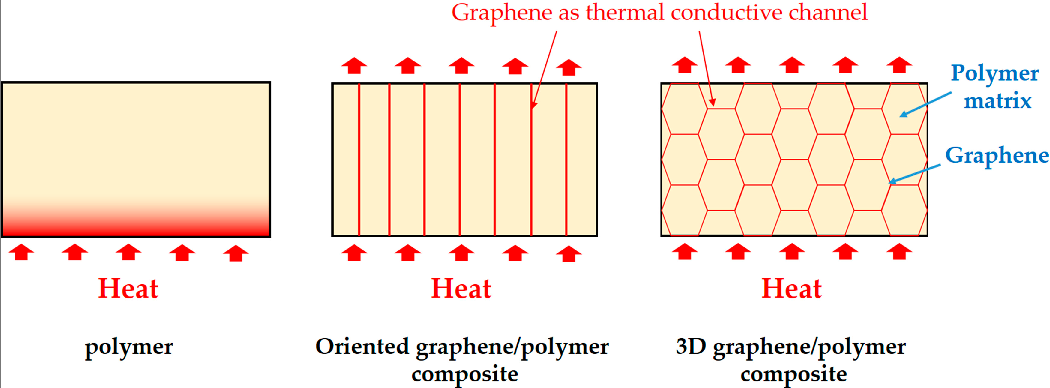 It consists mainly of nickel and chromium and is extremely heat resistant. Also resistant to extreme pressures, Inconel is indispensable in the production of aircraft black boxes and even rocket engine parts. Even more often, these features are used in solutions for the oil and chemical industries. The material is very strong and difficult to process, so direct laser sintering is preferred to obtain products of the desired shape. nine0003
It consists mainly of nickel and chromium and is extremely heat resistant. Also resistant to extreme pressures, Inconel is indispensable in the production of aircraft black boxes and even rocket engine parts. Even more often, these features are used in solutions for the oil and chemical industries. The material is very strong and difficult to process, so direct laser sintering is preferred to obtain products of the desired shape. nine0003
- Technologies: direct metal laser sintering
- Characteristics: heat resistant, wear resistant
- Applications: petroleum, chemical and aerospace industries
Nickel
Nickel alloys are popular for 3D printing applications. Nickel alloy elements are stronger and more durable than traditional methods such as casting. This, in turn, allows engineers to create thinner parts, leading to more fuel-efficient aircraft, for example. There are many types of alloys that combine the characteristics of nickel and other materials such as monel or inconel.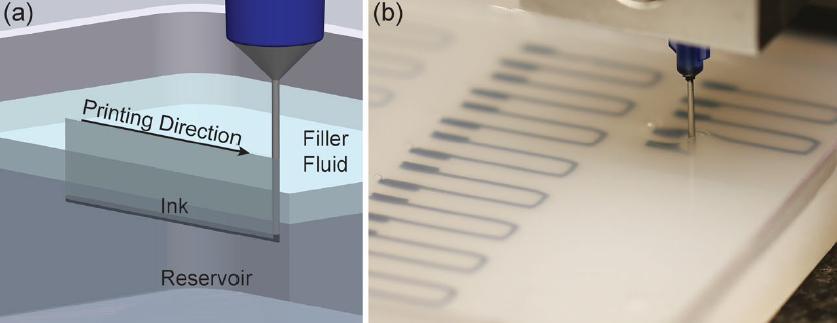 nine0003
nine0003
- Technologies: formed bed sintering, direct metal deposition
- Features: strong, lightweight
- Applications: series production (automotive and aerospace)
Precious metals (gold, silver, platinum)
Most formed bed sintering firms can work with precious metals such as gold, silver and platinum. Here, in addition to the aesthetic qualities of materials, it is very important not to lose a single crumb of precious powder. Therefore, such parts are more often produced where a more easily controlled investment casting technology is used. Precious metals are used as materials for 3D printing in jewelry, medical solutions and electronics. Depending on the technology used, some of these materials may be used for casting. nine0003
- Technologies: Formed-bed sintering, investment casting, bonded inkjet printing
- Features: high resolution, smooth surface
- Applications: jewelry, dentistry, functional models
Stainless steel
If you're looking for cheaper metal in this guide to 3D printing materials, it's stainless steel. It is also very durable and can be used in many industrial and even artistic applications. Stainless steel alloys containing cobalt or nickel are extremely difficult to break, but have excellent elasticity and good magnetic properties. If you need a different color - please: steel can be coated, for example, with gold. The materials in question are mainly used for industrial purposes. nine0003
It is also very durable and can be used in many industrial and even artistic applications. Stainless steel alloys containing cobalt or nickel are extremely difficult to break, but have excellent elasticity and good magnetic properties. If you need a different color - please: steel can be coated, for example, with gold. The materials in question are mainly used for industrial purposes. nine0003
- Technologies: direct metal deposition, binder inkjet printing
- Characteristics: high resolution, corrosion resistance, some flexibility, strength
- Applications: tools, function models, mass production
Titanium
Pure titanium powder is often used in 3D printing. This is one of the most versatile materials - it is both durable and lightweight. They work with it using the technology of sintering in the formed layer or inkjet printing with a binder. It is most commonly found in demanding medical solutions, such as custom-made prostheses. Other uses for this material are parts and prototypes for aerospace, automotive and tool manufacturing. In addition to the price, it has another unpleasant feature - its powder explodes easily. Therefore, they print in a vacuum or in argon. nine0003
Other uses for this material are parts and prototypes for aerospace, automotive and tool manufacturing. In addition to the price, it has another unpleasant feature - its powder explodes easily. Therefore, they print in a vacuum or in argon. nine0003
- Technologies: formed bed sintering, binder inkjet printing, direct metal deposition
- Characteristics: biocompatibility, high resolution, heat resistance, high wear resistance
- Applications: tools, function models, mass production (automotive, aerospace and medical)
CERAMIC
(Source: SONY DSC)
Ceramic is such a popular material for 3D printing in specialized services that custom-made coffee mugs, for example, have become commonplace. And with specialized extruders such as the WASP Clay 2.0, ceramics are also relevant in home 3D printing. nine0003
Clay consists of kaolinite and some other minerals, as well as a certain amount of water, which gives it plasticity.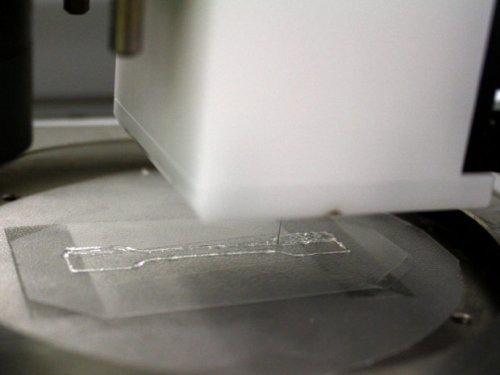 After the ceramic piece is printed, it is cured in an oven. The water evaporates and the minerals fuse together, maintaining the object's shape and strength. To make the printout shine, it is covered with glaze and placed in the oven again.
After the ceramic piece is printed, it is cured in an oven. The water evaporates and the minerals fuse together, maintaining the object's shape and strength. To make the printout shine, it is covered with glaze and placed in the oven again.
Ceramics can be printed using both conventional FDM technology and complex methods such as SLA. Beginning "potters" are offered a choice: glass, porcelain or carborundum (silicon carbide). The resulting products are distinguished by heat resistance and wear resistance and today most often act as works of art, as well as dishes and dentures. nine0003
- Technologies: FDM, binder inkjet, SLA
- Characteristics: heat resistance, wear resistance, brittleness, porous surface
- Applications: fine arts, mass production (dishes, dentistry)
WAX
Wax 3D prints are not usually the final product, but they are an important milestone in a long journey. They are relevant for very high resolution molding (0. 025 mm), as well as for investment casting. They are often used in the creation of custom-made jewelry, and at a relatively low price. Another industry that uses this kind of 3D printing materials is dentistry. When creating complex structures, wax, due to its low melting point, is an excellent material for props. nine0003
025 mm), as well as for investment casting. They are often used in the creation of custom-made jewelry, and at a relatively low price. Another industry that uses this kind of 3D printing materials is dentistry. When creating complex structures, wax, due to its low melting point, is an excellent material for props. nine0003
- Technologies: SLA, PolyJet
- Features: high resolution, smooth surface
- Applications: series production (jewelry, dentistry)
PAPER
With selective deposition lamination (SDL) technology, good old stationery around the corner finds its niche in 3D printing. SDL objects are tree-like, full-color, and this makes them popular in architectural and other conceptual models. On the other hand, parts made from SDL are not as strong as those made from other materials and do not have the level of detail that those made from PolyJet plastic or plaster. nine0003
- Technologies: Selective Deposition Lamination
- Features: cost effective, recyclable, full color
- Applications: concept models, fine arts
SANDSTONE
Sandstone as a printing medium is sometimes referred to as gypsum (in fact, gypsum is a component of natural sandstone) and is used to create impressive full-color objects in one process. To enhance the color and add strength, the printouts are covered with a protective layer of epoxy, without this the moisture will do its job and the sandstone will discolour. Objects turn out to be fragile, like porcelain, and this must be taken into account at the design stage. Bearing in mind the capriciousness of sandstone, it is mainly used in architectural models, concept prototypes and art projects. nine0003
To enhance the color and add strength, the printouts are covered with a protective layer of epoxy, without this the moisture will do its job and the sandstone will discolour. Objects turn out to be fragile, like porcelain, and this must be taken into account at the design stage. Bearing in mind the capriciousness of sandstone, it is mainly used in architectural models, concept prototypes and art projects. nine0003
- Technologies: FDM, binder inkjet, formed bed sintering
- Features: fragile, full color
- Applications: concept models, fine arts
(PHOTO)POLYMERS
(Photo: Nervous System)
Photopolymers are a type of liquid resin that hardens when exposed to ultraviolet (UV) electromagnetic radiation or visible light. Today, they work mainly on two technologies - SLA (stereolithography) and PolyJet. SLA uses a UV laser to project a slice of an object onto the surface of a photopolymer poured into a bath, which solidifies into the shape of the object's layer. This is repeated for all layers. nine0105 PolyJet technology takes a different approach. The printer directs a jet of resin onto a substrate, on which the resin is continuously cured by a UV lamp. SLA prints layers no thinner than 0.1 mm, and PolyJet produces up to 16 microns. And although the methods are similar and they use similar materials, the big difference lies in the methods of working with materials.
This is repeated for all layers. nine0105 PolyJet technology takes a different approach. The printer directs a jet of resin onto a substrate, on which the resin is continuously cured by a UV lamp. SLA prints layers no thinner than 0.1 mm, and PolyJet produces up to 16 microns. And although the methods are similar and they use similar materials, the big difference lies in the methods of working with materials.
All photopolymers are sensitive to sunlight.
SLA Resins
Many SLA Resins are designed to mimic the different properties of the "traditional" materials discussed above. For example, there are materials that are compatible with wax, they are used to create impressions in investment casting. And if biocompatibility is important, then there are thermoplastics for SLA, which are very similar to PLA. Other SLA plastics can be as strong as ABS. There are even composite materials for SLA printing that have the properties of ceramics: the objects obtained on the printer can be put in an oven and then treated like ceramic. nine0003
nine0003
Resins are an excellent choice for functional and conceptual models. They are especially good if you want to get a large object in a short time, while with a high level of detail. Some polymers even become hard enough for machining after quenching. In addition, high-temperature polymers are a cost-effective replacement for mold materials for low-volume moldings.
The popularity of the SLA process lies in its excellent speed and accuracy. The downside is that polymers are still significantly more expensive than everything that was mentioned here. nine0003
SLA printers are sold, you can work with them both at home and in a small office and use very interesting materials for semi-professional 3D printing.
- Technologies: SLA
- Characteristics: smooth surface, some flexibility
- Applications: concept models, functional models, fine arts, tools (prototypes)
PolyJet resins
(Source: Printshow)
Like SLA resins, PolyJet materials mimic the different properties of "traditional" 3D printing materials.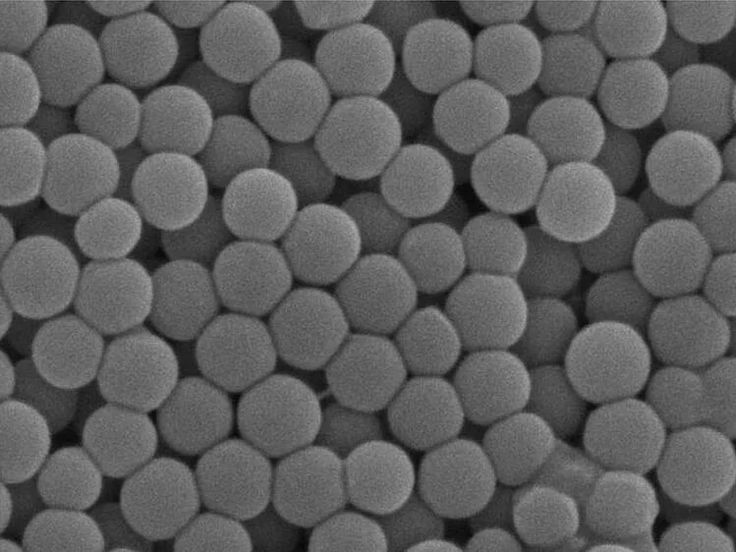 Most PolyJet resins have fairly descriptive names. For example, rigur is designed for strength and sounds similar to the Latin root for hardness. It is also called "simulated propylene" for the similarity of the surface and functionality. A number of 3D printing materials are referred to as "digital ABS" because they are heat resistant and durable. Rubber-like materials are designed for non-slip surfaces and to absorb vibrations. Since there are so many PolyJet polymers, we decided to refrain from a detailed description of each of them. nine0003
Most PolyJet resins have fairly descriptive names. For example, rigur is designed for strength and sounds similar to the Latin root for hardness. It is also called "simulated propylene" for the similarity of the surface and functionality. A number of 3D printing materials are referred to as "digital ABS" because they are heat resistant and durable. Rubber-like materials are designed for non-slip surfaces and to absorb vibrations. Since there are so many PolyJet polymers, we decided to refrain from a detailed description of each of them. nine0003
It should be noted, however, that PolyJet polymers differ from SLA in that they allow obtaining the so-called. digital materials. These are mixtures of up to three 3D printing materials to obtain specific properties (strength, heat resistance, transparency, etc.) for a specific part and in a specific color range. This is a bright path to radiant prospects. While other materials described in this review allow you to create only a visual imitation of "traditional" objects, objects from PolyJet can also imitate tactile sensations, actually replacing reality.


